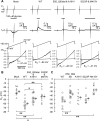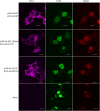Impaired neuronal KCC2 function by biallelic SLC12A5 mutations in migrating focal seizures and severe developmental delay
- PMID: 27436767
- PMCID: PMC4951812
- DOI: 10.1038/srep30072
Impaired neuronal KCC2 function by biallelic SLC12A5 mutations in migrating focal seizures and severe developmental delay
Abstract
Epilepsy of infancy with migrating focal seizures (EIMFS) is one of the early-onset epileptic syndromes characterized by migrating polymorphous focal seizures. Whole exome sequencing (WES) in ten sporadic and one familial case of EIMFS revealed compound heterozygous SLC12A5 (encoding the neuronal K(+)-Cl(-) co-transporter KCC2) mutations in two families: c.279 + 1G > C causing skipping of exon 3 in the transcript (p.E50_Q93del) and c.572 C >T (p.A191V) in individuals 1 and 2, and c.967T > C (p.S323P) and c.1243 A > G (p.M415V) in individual 3. Another patient (individual 4) with migrating multifocal seizures and compound heterozygous mutations [c.953G > C (p.W318S) and c.2242_2244del (p.S748del)] was identified by searching WES data from 526 patients and SLC12A5-targeted resequencing data from 141 patients with infantile epilepsy. Gramicidin-perforated patch-clamp analysis demonstrated strongly suppressed Cl(-) extrusion function of E50_Q93del and M415V mutants, with mildly impaired function of A191V and S323P mutants. Cell surface expression levels of these KCC2 mutants were similar to wildtype KCC2. Heterologous expression of two KCC2 mutants, mimicking the patient status, produced a significantly greater intracellular Cl(-) level than with wildtype KCC2, but less than without KCC2. These data clearly demonstrated that partially disrupted neuronal Cl(-) extrusion, mediated by two types of differentially impaired KCC2 mutant in an individual, causes EIMFS.
Figures





Similar articles
-
Mutations in SLC12A5 in epilepsy of infancy with migrating focal seizures.Nat Commun. 2015 Sep 3;6:8038. doi: 10.1038/ncomms9038. Nat Commun. 2015. PMID: 26333769 Free PMC article.
-
A de novo missense mutation in SLC12A5 found in a compound heterozygote patient with epilepsy of infancy with migrating focal seizures.Clin Genet. 2017 Dec;92(6):654-658. doi: 10.1111/cge.13049. Epub 2017 Sep 15. Clin Genet. 2017. PMID: 28477354
-
A novel pathogenic SLC12A5 missense variant in epilepsy of infancy with migrating focal seizures causes impaired KCC2 chloride extrusion.Front Mol Neurosci. 2024 Apr 10;17:1372662. doi: 10.3389/fnmol.2024.1372662. eCollection 2024. Front Mol Neurosci. 2024. PMID: 38660387 Free PMC article.
-
The KCC2 Cotransporter and Human Epilepsy: Getting Excited About Inhibition.Neuroscientist. 2016 Dec;22(6):555-562. doi: 10.1177/1073858416645087. Epub 2016 Apr 29. Neuroscientist. 2016. PMID: 27130838 Review.
-
Pathogenic potential of human SLC12A5 variants causing KCC2 dysfunction.Brain Res. 2019 May 1;1710:1-7. doi: 10.1016/j.brainres.2018.12.025. Epub 2018 Dec 18. Brain Res. 2019. PMID: 30576625 Review.
Cited by
-
The Expanding Therapeutic Potential of Neuronal KCC2.Cells. 2020 Jan 17;9(1):240. doi: 10.3390/cells9010240. Cells. 2020. PMID: 31963584 Free PMC article.
-
Crossing the Chloride Channel: The Current and Potential Therapeutic Value of the Neuronal K+-Cl- Cotransporter KCC2.Biomed Res Int. 2019 May 21;2019:8941046. doi: 10.1155/2019/8941046. eCollection 2019. Biomed Res Int. 2019. PMID: 31240228 Free PMC article. Review.
-
Early establishment of chloride homeostasis in CRH neurons is altered by prenatal stress leading to fetal HPA axis dysregulation.Front Mol Neurosci. 2024 Mar 21;17:1373337. doi: 10.3389/fnmol.2024.1373337. eCollection 2024. Front Mol Neurosci. 2024. PMID: 38577026 Free PMC article.
-
N-Ethylmaleimide increases KCC2 cotransporter activity by modulating transporter phosphorylation.J Biol Chem. 2017 Dec 29;292(52):21253-21263. doi: 10.1074/jbc.M117.817841. Epub 2017 Nov 1. J Biol Chem. 2017. PMID: 29092909 Free PMC article.
-
Solute carrier transporter disease and developmental and epileptic encephalopathy.Front Neurol. 2022 Nov 7;13:1013903. doi: 10.3389/fneur.2022.1013903. eCollection 2022. Front Neurol. 2022. PMID: 36419532 Free PMC article. Review.
References
Publication types
MeSH terms
Substances
LinkOut - more resources
Full Text Sources
Other Literature Sources
Medical

